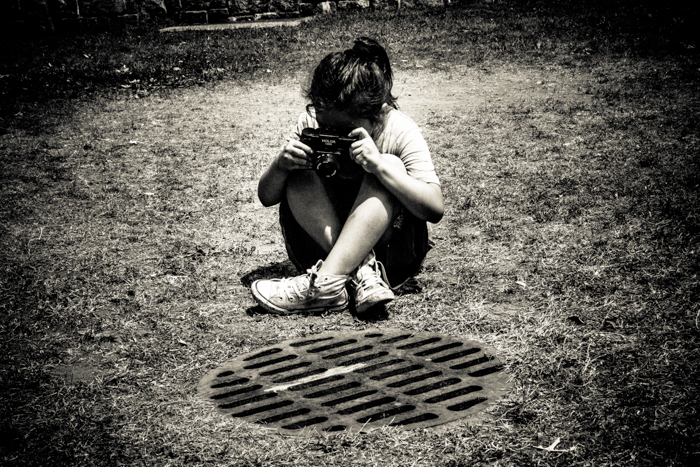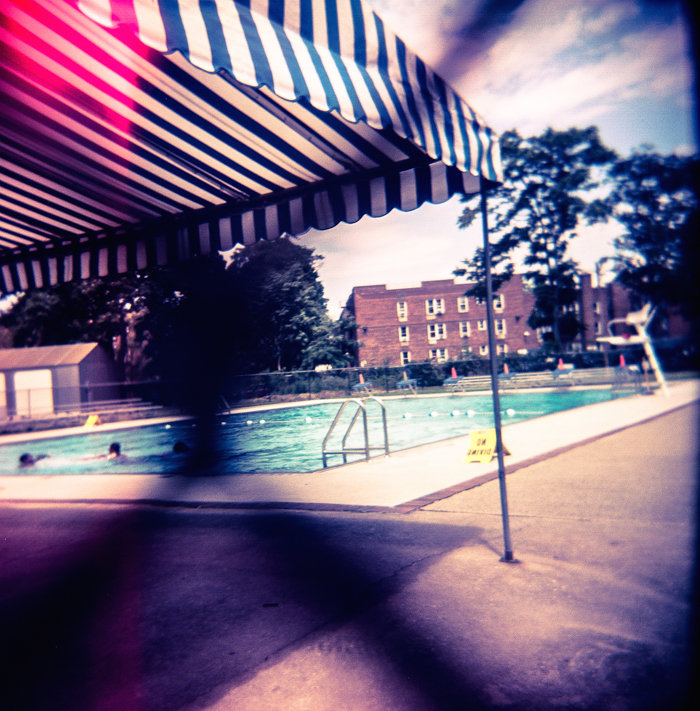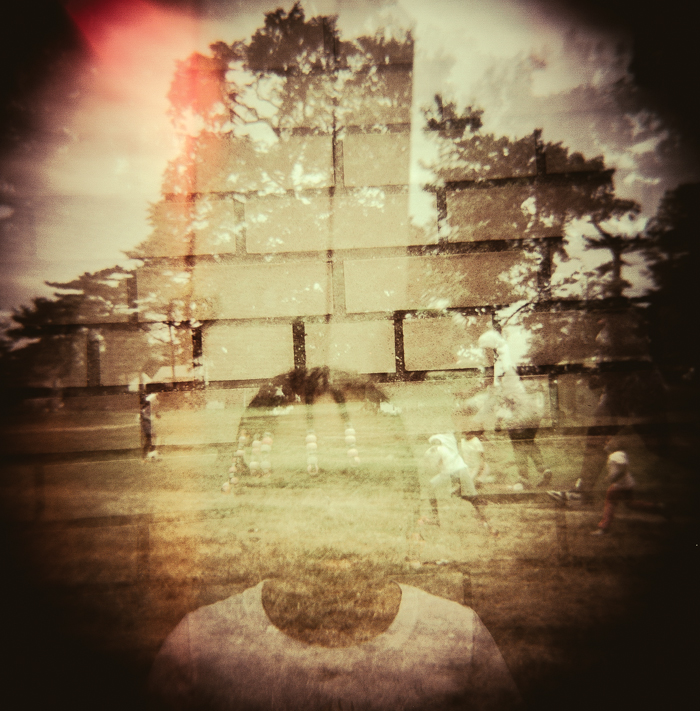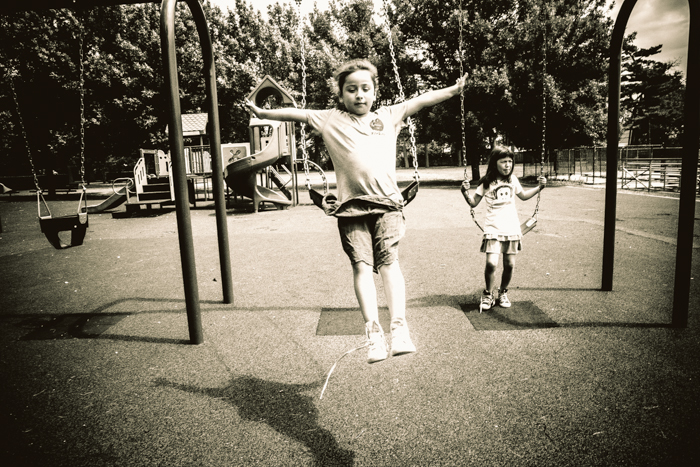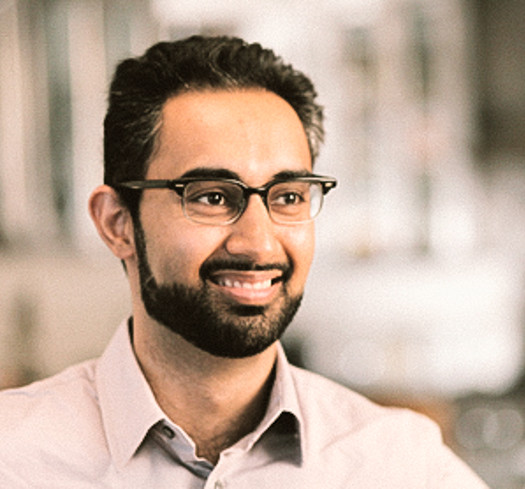Camp Kid Warrior: Fighting for Hope with Health

Portraits by Sarah Takako Skinner, Executive Producer of The Hope Is Project Holga photos by Ashley and Diana
Boxing Champ Cara Castronuova Gives, and Gets, Hope with Camp Kid Warrior
“I want to be stronger because I want to stand up to the world. A girl who’s strong and isn’t scared of the people, that can sing loud, and that just lets it go.”
Eight year old Diana expresses one of her hopes, as she trots purposefully around a park in the town of Hempstead, Long Island. She and her seven-year-old sister Ashley take turns with a Holga camera, capturing frame after frame of sights they feel inspire the notion of hope, all while shadowed by the founder of The Hope Is Project, Sarah Takako Skinner. Skinner watchfully documents their experience on her own digital camera, and coaches their progress.
The young El Salvadorian immigrants are summer campers of Camp Kid Warrior, a passion project of Cara Castronuova, a two–time Golden Gloves boxing champion, former lead fitness trainer for NBC’s hit show “The Biggest Loser”, actress and celebrity fitness trainer. The athlete, or “Miss Cara” as the campers call her, has traded boxing gloves for hope as a weapon of choice.
The Hope Is Project, Skinner’s bold documentary experiment, challenges people with adversity to find inspirations of hope and photograph them with special cameras, endeavoring to explore the nature of the universal concept. As Skinner spends a summer day with Castronuova and the two young sisters at the summer camp, they look for images which, to them, embodied hope. They talk of their lives, the camp, and the very idea of hope.
There are two stories here. One is of two children surviving a challenging world. The other looks behind an experience seeking to inspire them both to reach for healthier and more meaningful lives.
“They don’t have much, they live on a very, very tough street,” Castronuova shares, clearly emotionally invested. The sisters have witnessed vicious attacks, and they see things as if the dangerous environment is normal for them. “They are so sweet with everyone, and one day I drove them home,” the boxing champ continues, coming across as much like a spunky Hollywood starlet as a ferocious fighter. “I saw how quickly their demeanor changed. They turn on a protective barrier switch and they’re not sweet anymore, they turn into these tough girls. Like really hard. It was crazy.”
Diana and Ashley are but two of many children from the Camp Kid Warrior who reside in a neighborhood infested with drugs and danger. When asked about her own thoughts on hope, Ashley says she needs more of it. “The street is bad for us. I want to get hope because I want to move because the street will never change, will always stay the same.” She recalls witnessing drinking and men coming around the neighborhood, and that it used to be “all good and nice and someone got killed.” She watched the murder unfold. “It was someone’s birthday.”
All of the children in the camp have claimed a place in Castronuova’s heart. But since the day she met them, the sisters have held a special bond with her. Despite a successful first year and evident popular interest in another, a day before Camp Kid Warrior started its second summer Castronuova made a startling discovery: zero enrollment. Like any good fighter, she took matters into her own hands, scrambled and went to work handing out flyers in the town’s park where the camp is based. Language barriers prevented many parents, largely El Salvadorian immigrants, from understanding her. Frustrated, she encountered bilingual Diana and Ashley in a park bathroom and asked them if they would be interested in attending camp.
“They jumped up and down. They were so excited,” says Castronuova, “We wanna go! We wanna go!” The girls exuberantly helped hand the flyers out and translated. Combined with the results of Castronuova’s own visits to a few area Baptist churches, within a day the camp’s fifty-camper limit had been surpassed—by ten. Sixty campers, all there for the same reason: something better.
The camp’s original objective was to provide specific attention to a small number of kids who needed focused help. Castronuova believes more in providing a large benefit to a few than a small benefit to many. In the end, though, the needs of the many won out. “We had more kids than we expected,” marvels Castronuova, “but we just couldn’t turn kids away. The town of Hempstead was co-sponsoring it. I am glad we didn’t turn them away, because the kids needed to be there. Any kid would benefit from it.”
Asked about her future, Ashley wants to be a pop star. Diana envisions becoming a doctor, specifying she wants to be one who “gets paid.” For both sisters, whom Castronuova calls “good girls,” attending camp has afforded opportunities and a safe haven as well as a role model in the boxing champion. “My dad put us in this camp to express ourselves to see things you really don’t know,” Diana reveals. “I’m learning how to be brave. How to be an artist, singer, dancer—everything.” Then she gets serious. “The things that make me feel good is when people do not dies (sic) in my school. That would look like fun. A place where you can express yourself.”
Castronuova does not take this lightly, and sees the clear relationship with hope from her perspective as an athlete, boxer and trainer. “Ninety percent of boys in this area want to become an athlete, girls an athlete or dancer. When you are active, the feeling of release and that everything is OK makes you feel more hopeful, like you get this bag of bricks off your back. I can do this. I can do this.”
The fitness trainer wants to share that experience with as many people as she can. “Kids of a young age, they sense that physical motion, literally. It is like a secret to ‘the zone’. Some people call it Zen Buddhism or Nirvana, that feeling of being in the moment. And kids love that feeling and that’s why they stay there.” Castronuova points out that most children are not watching doctors or engineers on television; the successful people to whom they are exposed are typically athletes or celebrities. “That’s what they want. The have big dreams at a young age.”
As Diana and Ashley see objects, other children, and sights representing hope through the camera’s viewfinder, Ashley sees a park pool and wants to capture the image on film. When asked, she relates that the pool means fun, freedom and something she doesn’t usually have access to in her life, particularly due to the entrance fee. An employee chases her away, scolding her for trying to take a photo, referencing swimsuits, privacy and the fee (despite smartphones snapping within the confines of the chain link fence). Even when Skinner offers to pay Ashley’s way in so she can grab the image she wants, the girl still declines, perhaps feeling it is somewhere for others but not her. Instead, Ashley snatches an image through the chain links, peering at the forbidden from what might be a familiar vantage point. Days later, when Skinner first sees the developed frame, it is a moment which brings emotion; does this photo show how this child often sees hope for a better life, but just out of reach?
Despite their youth, Ashley and Diana appear to be catching a shimmer of the big picture of health and self-expression. “Cara made this camp because they want us to get healthy,” says Ashley. “We do want to get healthy.” Diana adds, “I hope for a better place. A happy day, with flowers, nice people, my friends, express yourself.”
Funded in part by Knock Out Obesity (a foundation focused on mission to “combat childhood obesity by providing nutritional and physical education, and programming, using the tenets of boxing”), Camp Kid Warrior gets its name partly inspired by Castronuova’s professional fighting background, and she insists it be seen purely as an “empowerment camp”. She is quick to state that the word “obesity” scares some people and that it does not connote the concept of fun. In fact, three-quarters of kids attending the camp are not even overweight, but instead possess poor eating habits (primarily due to any combination of lack of education, funds or attention from their parents) which Castronuova says ensures serious future health problems if unchanged.
The camp was opened to kids of all shapes who are willing to learn about health and fitness. “Being healthy makes them feel empowered. We have a warrior theme, warrior cries, and it all makes a kid feel like they want to come to camp and be more active because of the name,” says Castronuova. Simply learning about choices can make a measurable difference. When she asked the campers which was healthier—fried chicken or baked chicken—more than half chose fried since that is what they eat. “I also asked what’s healthier white or brown rice,” she adds. “I found out the last day that none of them had ever had brown rice. That hadn’t even occurred to me.”
Aside from providing children with a memorable and impactful experience, there is a main mission at Camp Kid Warrior: providing a positive affiliation with eating well and being healthy, starting from a young age. Castronuova asserts that it is very difficult to break away from childhood affiliations of any type. Even as adults, as we become interested in change and growth, the availability of information and resources is not enough; one must have a true desire to break from those affiliations, despite a likely emotional tie to them.
One day of the camp, Castronuova polled the campers why they like McDonalds’ Happy Meals. Overwhelmingly, it was because of the toys. When asked to choose between a grilled chicken and vegetable meal which came with a toy, and a Happy Meal with no toy, every child chose the meal with the toy. “It comes down a psychological affiliation,” concedes Castronuova. “There’s no way I can teach the sixty kids everything. But give them a fun summer mixed with health and fitness, they will associate fitness with fun and be left with positive feelings.”
In challenging moments, she continues, even this champion athlete and trainer reverts to thoughts of Taco Bell and McDonalds since that is where her own parents brought her as a child. She says this is common, and many children experience food as a reward such as getting ice cream after soccer game or candy when they are upset. “Never use food as a reward,” she cautions. “I have a really big non-food rewards system—inexpensive toys, stickers etc. I want them to feel like they really accomplished something. A kid will say ‘Miss Cara, I brought carrots today’ and they get a prize or tickets right away. They trade tickets for prizes. And it gives them a good feeling.”
In the end, Castronova is hopeful she provides the campers with a “lasting and positive impact through the medium of health and fitness.”
For many kids without something in their lives to offer this kind of glimpse of hope, such as this camp, she worries for their futures. “Each kid I meet, it’s scary; they’re innocent and they’re just kids,” she says. “They’re not tough. An eight-year-old kid is a kid, no matter where they’re from. The decisions they’re going to have to make growing up in a tough village is heartbreaking. One of the girls said ‘I can’t believe I get to go to camp’, because it’s not something that ever crosses their mind.”
As a kid herself, being a boxer was the only way Castronuova felt she could focus her energy, and it required tremendous work ethic. She reflects on this and adds, “Give them the spark to see there are more things outside of what they see in their lives. One thing that can give kids this is a place, an inspiration, an escape. A way to express themselves creatively, with dancing, boxing arts and crafts, cultural trips, expose them to so many different things. Things to do, even those in their own village, and not being on the street.”
As she watches Skinner working with Ashley and Diana finding images of hope through the lens of the camera they are sharing, Castronuova pauses to reflect on her own vision of hope. “It means ‘kid’.”
She clarifies, never taking her gaze off of the two girls while somehow always attending to the other children who frequently approach her. “The reason I prefer to work with kids: adults are so hard to get to. Against the current.” Castronuova clings to possibilities, saying that when a kid is young, they still have hope. “They can go one way or another way. When I’m around kids I love how hopeful they are. They’re so innocent and have so much to look forward to, if they do the right thing. There’s an age when they become jaded, and it becomes really difficult to get through to them.”
The fighter starts towards the warrior sisters who are returning from their photographic odyssey, and she turns back, adding, “They give me hope. I’m helping them, but they’re helping me.”
Diana looks on as her warrior-sister is asked again what the word hope means to her. Quickly, and eagerly, seven-year-old Ashley volunteers how things look from her evolving perspective. “Hope means life getting better for you in the future. If you start hoping, you’ll get more hope.”
LEARN + CONNECT
Learn more about Camp Kid Warrior and The Hope Is Project
Connect via Facebook, Twitter and Instagram
Story by Marc Raco, Executive Producer of The Hope Is Project
FROM THE EDITOR
At Conscious, we are inspired by remarkable people and organizations and so we set out to tell stories that highlight human interests, global initiatives, innovation, community development and social impact. You can read more stories like this when you subscribe.

